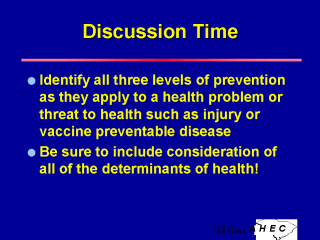Primary
prevention
Activities known to help prevent disease or ill health prior to its occurrence are
classified under primary prevention. The practice of healthy habits such as eating a
healthy diet, being physically active, and moderating alcohol intake are examples of
habits that can help lower one’s risk of disease. Other health behaviors can help
prevent accidents or injuries.
Immunizations provide protection against the onset of bacterial
infections or viruses. Historically, children are vaccinated against a host of diseases
prior to entering school. However, more vaccines are being developed that can be useful at
later stages during the life cycle such as the flu vaccine and those developed to protect
against hepatitis. Immunizations are some of the strongest and most successful disease
prevention agents.
Secondary prevention
Action taken to enable early detection of a health problem and to stop or modify
the severity or extent of illness are considered secondary preventive measures. For
example, when a woman receives a mammogram to identify unusual areas in the breast tissue
or a man gets his PSA measured, these are screenings that can help identify early cancer
growths.
